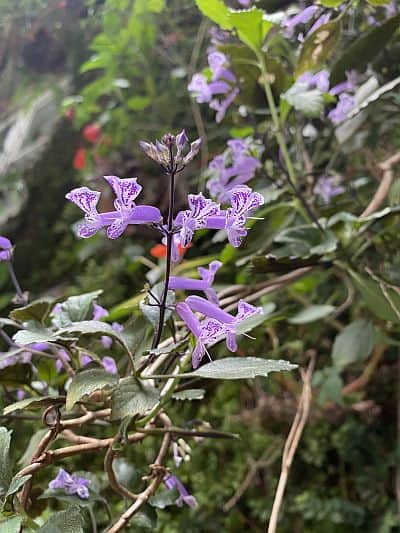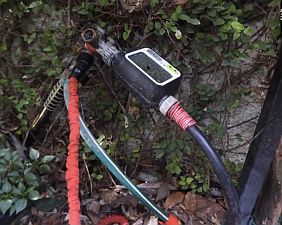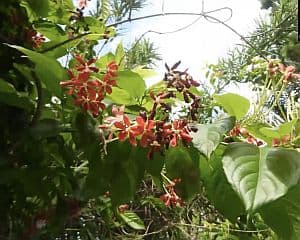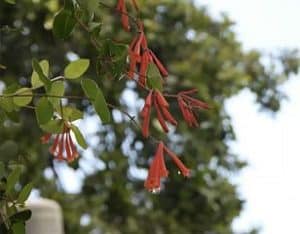(Image above: Plectranthus ‘Mona Lavender’)
Drip Watering Systems and Pollinator Plants that Attract Hummingbirds
Master Gardener Seth Nehrbass recently spoke to our Master Gardeners of Greater New Orleans about how to set up Drip Irrigation in our gardens. He also gave use some of his best tips on pollinator plants that attract hummingbirds. I attempted to sum up some of his best suggestions.
You don’t have to be an expert to set up your own drip watering system. With ¼ or ½ inch tubing, use T-connectors to break into the tubing and add other lines to reach your plants. ¼ or ½ tubing connects directly to the hose. Use ½ tubing for a larger supply of water to reach more plants. Drippers are used to get more or less water to plants by simply turning the dripper. Drip watering systems are great for in ground plantings, pots and hanging baskets. Seth will layer plants using drippers on higher plants which drain to lower plants. He suggests we keep in mind, some plants may not do well with drip irrigation and will need to be monitored.
(Image above: [left] 1/4 in T connection, adjustable dripper, orange hole punch, connector & 1/4 inch tubing top right.; [right] Tubing connected to timer, connected to hose.)
If drippers clog, simply take them off to dislodge any clogs, if still clogged, soak the dripper in vinegar overnight and they should be fine. Supplies are available at Home Depot or Lowes. Seth sets his timer(s) to water his plants 3 times daily for 10 minutes each time. Plants closer to drippers get more water. He uses wire pins to secure drippers to the ground to prevent squirrels from moving drip lines. He also will secure above as needed to secure tubing to hanging baskets. He uses hooks to direct lines around the perimeter of his house. Seth uses gutters to catch run off from hanging baskets to protect his patio and divert water to other planting areas of his yard. He has different drippers positioned to several birdbaths. And a mister attached in another area for other birds.
Seth has four rain barrels to collect rainwater. Three barrels are used to divert water into specific areas of his yard, one rain barrel he uses for rainwater to water plant. To protect his tender plants from freezes, Seth covers his tender plants during significant freezes with a curtain he created. He secures the curtain on the outside of his patio or porch to create an enclosure using Velcro to open and close as needed.
(Images above: [left] Russelia Sarmentosa; [center] Rangoon Creeper; [right] Coral Honeysuckle)
Seth’s List of Pollinator Plants that Attract Hummingbirds:
(these plants survived this past winters’ freeze)
- Angle Earrings Fuschia – developed in Japan. Can be propagated from cuttings. Will grow year-round in New Orleans. Survived in the hottest part of the season (Purchased from Bantings, Urban roots, grow Joy)
- Bat-Faced Cuphea – exotic blooms, roots easily
- Pineapple Sage – pink, red tubular blooms
- Cape Honeysuckle vine – orange tubular blooms
- Coral Honeysuckle – native takes cold weather
- Fuschia – common Fuschia with colorful blooms do best in morning sun, keep cooler when it gets too hot and they may survive longer
- Hotlips Sage – pink, white and bicolor flowers
- Lantana – can tolerate dry conditions, dies back in hard freezes but comes back every year.
- Pineapple Sage – dark pink, red flowers
- Starfire Pink Cuphea – easy to root from cuttings
- Rangoon Creeper or Chinese Honeysuckle, Combretum indicum – flowers white, pink, dark pink to red by the end of the day, remain for several days and drop off red. Survived this years’ freeze.
- Red Mandevilla – vining plant with trumpet blooms
- Red Flowering Maple – planted in the ground can get 20 feet tall; easy from cuttings
- Red Shrimp Plant – did well this past winter, survived 26 degree temperature
- Russelia sarmentosa – small flowers attract hummingbirds; full sun, overwatering can kill this plant

This information was taken from an educational talk by Seth Nehrbass, Master Gardener of Greater New Orleans.
(Image right: Fuschia)

By Karen Blackburn






